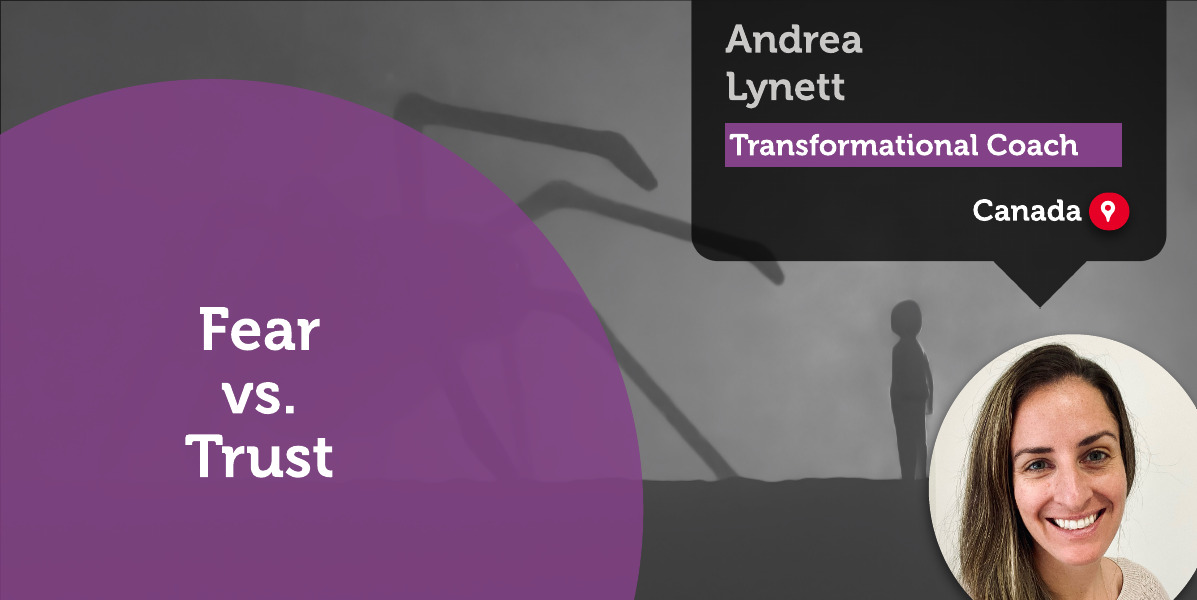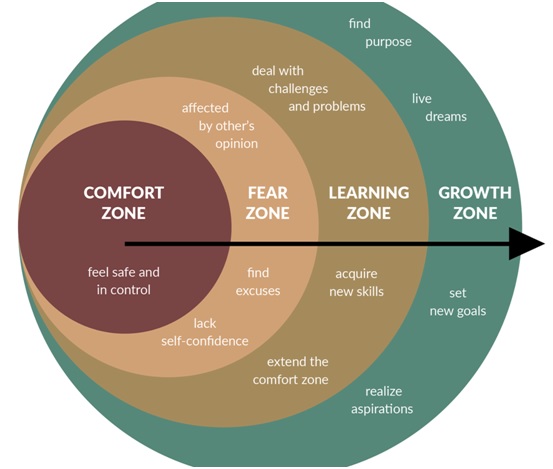A Coaching Power Tool By Andrea Lynett, Transformational Coach, CANADA

How to Help Someone With Fear vs. Trust Issues
Everything you’ve ever wanted is on the other side of fear – George Addair
- Learn how to shift or reframe a perspective
- Explore the idea of partnering with the client to move from fear to trust, with actionable outcomes
In this context, we aren’t talking about fear in the sense of ‘clear and present danger’ (physical danger) – but more in the context of fear of the unknown. We’ll look at how to recognize the fear, root causes, and beliefs and how to help guide a client to ‘the other side of fear’. Ultimately, reframing their mind towards trust– trust in themselves, their ability, and trust that it will all work out how it’s meant to be. In many respects, a little bit of fear in our lives is natural and healthy, and it can help propel a person in a forward direction.
From an evolutionary perspective, fear and anxiety are quite useful. These deeply ingrained emotions are used to protect our ancestors from predators, and in our times the “fight-or-flight” response is still a healthy reaction to dangerous situations. When fear is proportionate to the danger a person is in, it is a normal, adaptive response. However, some of us have exaggerated reactions to stressful situations. As the National Institute of Mental Health explains, when the fear response is disproportionate or lasts a lot longer than what is normally expected from the situation – to a point where it interferes with an individual’s well-being and daily functioning – it is classed as an anxiety disorder. 1
The Concept of Fear – What Is It?
Definition of Fear:
An unpleasant emotion or thought that you have when you are frightened or worried by something dangerous, painful, or bad that is happening or might happen. 2
Fear is a common but counter-productive response to uncertainty. When fear dominates, the creative brain shuts down. Here is how it works….
When fear dominates, the primitive brain takes over, releasing cortisol and catecholamines—hormones released during emotional or physical stress. These chemicals shut down the brain’s prefrontal cortex, or executive functions, which enable sophisticated strategies, trust, integrity, and strategic thinking. Instead of responding intelligently and creatively to people and situations, you freeze, coming across as unintelligent or defensive. Appreciation and Trust, on the other hand, minimize the impact of cortisol, and enables oxytocin, the bonding hormone, to flood the brain – elevating our ability to have a voice and partner for mutual success.3 (Psychology Today)
Fear ultimately causes some sort of suffering. And for certain people, this suffering can be fleeting, or long-lasting (anxiety, mental illness, PTSD, etc). People are either suffering about what IS (future) going to happen, or they’re suffering because they are dwelling on what ALREADY happened (past).“So suffering is always around that which does not exist – that which is not rooted in reality. It is focused on the trappings of the mind. One part is memory (the past) and another is imagination (the future). But neither one exists.”4
What fear does is it puts boundaries around you. It is because of fear that you build boundaries all the time. If you put boundaries and restrict the area of your life, you may be safe; but the problem is you are safe even from life. You are protected from life itself. 5
And thus, you are stuck in your protective bubble. But not truly living your life. If we look at fear, most people have a fear of the unknown – or the future. Fear of something that hasn’t happened yet – something that is out of their control. And oftentimes, this fear can be enough to prevent someone from moving forward. For example, a friend or client of yours expresses to you that her husband is abusive, and she knows she needs to leave him, for her sake and her children’s well-being. But she’s paralyzed by fear. She can’t see how she could survive without him. She doesn’t think she’ll be able to survive as a single mom and do it all on her own. She’s not sure how she will be able to pay the bills? How will her kids handle the separation/divorce? How will she ever find someone else? These are all valid fears and ones that need to be acknowledged and potentially examined. But neither of you have the answers to the future or a crystal ball. Therefore, these questions are rooted in the unknown. Fear is a by-product of our mind. We suffer because we are not rooted in reality.
The type of fear that we are going to be assessing and helping our clients work through, as coaches, is the type of fear that keeps us stuck or holds us back from following our dreams, passions, and curiosities. Fear that stops us from living in our truth and accessing our authentic selves. For example, a fear of being vulnerable in a new relationship because in the past, when the client expressed their vulnerability to their partner, the person either left them, disregarded their feelings, or didn’t even acknowledge their emotions. For obvious reasons, this would bring up fear around future relationships within the client and could easily keep a person stuck and or paralyzed by what the future of their love life will look like.
What is TRUST in the Context of FEAR?
Definition of Trust:
The textbook definition, according to the dictionary is “Assured reliance on the character, ability, strength, or truth of someone or something.”6
As previously discussed, a lot of our fears stem from past experiences – i.e. a loved one dying unexpectedly- presenting a new fear within us around dying or loss. Or maybe we went through a horrible break-up that left emotional scarring, so a person becomes fearful of giving their heart away again to someone new, for fear that this new person will do the same thing as a past lover. Additionally, a person may be fearful of what their future holds, so they stay in a job they hate because it’s comfortable and they know it well, a marriage they despise because it’s familiar or a city that no longer fills their soul. Essentially, fear can leave a person stuck and immobile. It’s way easier to stay in a known and familiar experience than it is to venture into the unknown.
But isn’t life in general, unpredictable? Isn’t that what makes life worth living? Isn’t that how we keep a life exciting – diving into the unknown?
When we build walls around us to protect ourselves from our fears, we miss out on so much and end up hurting ourselves in the process. If we allow the fear of people and opportunities to permeate our lives, then our lives become limited and the world around us becomes very small.
Trust is one way to move through fear. Ernest Hemingway said, “the only way to trust someone again is to trust” and the same goes for anything else in our lives that’s masked by fear. Sounds simple, but it takes work to invoke the inner trust muscle. And as coaches, we have to recognize that this can take time for a client to fully comprehend. It’s not something that will happen overnight. Trust is something that we have to actively work at, think about in the context of our situation, and then put into practice. The good news is that humans are extremely resilient. Even though our ego doesn’t like being rejected, hurt, laughed at, or being forced to face the unknown, we can move through the fear that comes with those experiences when we lean into trust and the possibility of what could be.
Why Is Fear vs. Trust Important in Coaching
Instead of focusing or dwelling on the fear, we need to help our clients recognize it, acknowledge it for what it is and assist them in reframing their views through a trusted lens. Helping them to build more trust in themselves, their decisions, and the outcomes that may follow – without attachment and knowing. With more vulnerability, courage, and trust, there is little room for fear to exist. As many experts have pointed out, a little fear in life isn’t necessarily a bad thing. Building trust in ourselves can help a person with their self-confidence and decision-making abilities.

Strategies to Help a Client Move From Fear vs. Trust
1) Have the client write down their fears and acknowledge their existence
2) Explore a client’s excuses (I.E – I’m too old, there’s not enough time, I can’t do it because…, etc) And switch the mindset to a more positive one through powerful questioning
3) Figure out where their comfort zone is and what their capacity is for change (Every client will be different). You don’t want to push them too far before they are ready.
4) Try out some mindfulness techniques if they are open to it(Envisioning what they want, and trusting that they can achieve it). This will also help them to live in the present moment, and not in the ‘what if/Fear mindset’ of the future or the past.
5) Focus on moving them towards positive thoughts (Gratitude, abundance, trust) – because fear can’t co-exist in a positive thought is present
6) Help them to embody more of a growth mindset (Our abilities are not fixed, but rather flexible). What we want in life is achievable if we trust in ourselves and our abilities. The trust will help them realize their aspirations are attainable.
Life Doesn’t Happen to You, It Happens for You
Presenting them with questions like:
- Where do you feel the fear comes from?
- How is the fear serving you?
- What would it feel like to release the fear?
- What do you envision is possible for your life?
- What could your life look like without the fear present?
- What if you replaced fear with trust, what would be possible then?
- What would be trusting yourself look like?
- How would you feel if you trusted yourself completely?
- What does trust mean for you?
- What are some ways you can build up your inner trust muscle?
- What else might help you bring more trust into your life?
- Who could you be without the fear?
- What do you need to put in place to help you be more decisive with your decisions?
- How can you be more compassionate with yourself and where you are at?
- What do you need to put in place that will help you choose trust over fear?